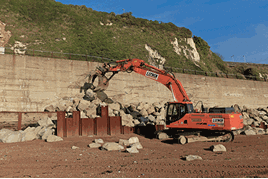So what work has been done during the ten-week closure? And why is NR unable to announce a timescale for repairs and eventual re-opening? Kilby outlines the four-stage process that he and his team are currently following.
“I got on site on Boxing Day and the cracking had continued. The first stage was safety, as there is a public footbridge crossing the line over the damaged section. We spoke to Kent County Council to have this closed and then dismantled, and we closed part of Shakespeare Beach so members of the public could not be endangered by bits of wall falling down.
“The second stage is asset protection. The whole sea wall is over 1,000m long, which we didn’t want damaged any further. So we placed more than 9,000 tonnes of rock armour to pin the wall in place in the main fracture areas.
“It took a further two weeks to get it stable, as we couldn’t put men or machinery on the trackbed above until it was stabilised. Then we disconnected the signals, protected live cables and lifted the track to create a worksite.”
Remedial action at Shakespeare Beach has been further hampered by the tidal pattern at this narrowest point of the English Channel. Working time is limited to four hours each day on the beach, which becomes three because of the time taken to move heavy lifting vehicles into position.
The next stage of the process Kilby embarked upon was investigation, because to counter the voiding of the earth beneath the track alignments, its soil mechanics and profile had to be fully understood.
Network Rail knew that this section of track had an unusual history, but soon came unstuck when trying to establish its exact construction, or the strength of its integrity.
Kilby explains: “Back in the 19th century the Victorians were great at building wooden piers, and decided to build a wooden trestle to carry this part of the line from Shakespeare Cliff Tunnel, across the beach and into Dover. In 1927 a sea wall was built in front of it to make room for a siding, and the box back-filled with chalk from the dismantling of a tunnel nearby. Hardcore was put on top and then ballast.
“It had been solid with very little settlement for many, many years. The only technical issue we ever had here was sea spray corroding the rails. But we needed to see what state the trestle was in, and if we could use this material in the rebuild.
“Our contractor Costain dug three huge test pits and used a number of methodologies to assess the state of the timber using drills, probes and visual inspection. We took samples and established the type of wood, which is true pine.
“Unfortunately, due to years of being surrounded by wet chalk it has rotted and is unsound to build on. We cannot use it in any future repairs and it will probably have to be removed. All this was needed because we had no historical records.”
He adds: “You certainly wouldn’t build a sea wall now as they did in 1927. You would have more drainage mechanisms for a start, and they did odd things like use bullhead rails to anchor the trestle.”
The final stage is permanent repair, and NR is still finalising its designs ahead of an announcement that RAIL understands will be made before the end of March. Even so, the timescale for re-opening looks certain to be in months, rather than weeks.
In the meantime, rock armour continues to be brought to the beach by barge, to form part of the permanent fix.
“Initially we brought 120 lorry loads of rock armour by road. Now we have 23,000 tonnes brought by barge from Norway. It has to come from there, as the rock armour we need has to be mined from the deep sea so it is has no fissures or cracks.
“There are few places in Europe to get it from, and the most economic way to bring it is by barge straight to the beach. It’s also taken the equivalent of 700 lorries off the A20.
“With the sort of design we will need, normally it would take nine months to start building, but we’re doing it in weeks. The Orange Army’s designers have worked really hard and we’re almost at the stage to start building.”
- This feature was published in RAIL 795 on March 2 2016.
















Login to comment
Comments
FrankH - 22/08/2016 22:32
Due to re open Monday September 5th, 3 months ahead of schedule.